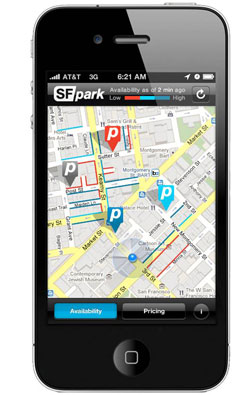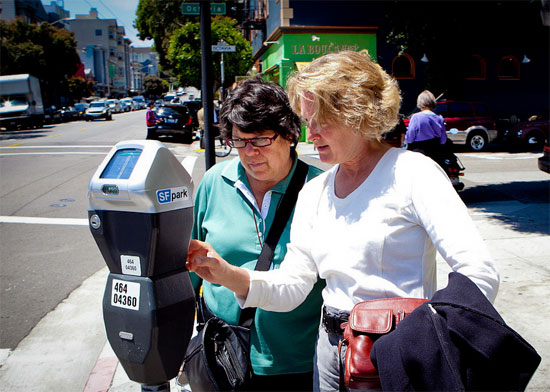The central principle of San Francisco's cutting-edge parking management program, SFPark, comes right from Econ 101. If there are more people looking for parking than there are parking spaces (i.e. demand is greater than supply) adjust the price of parking until there is enough turnover on a given street, or roughly one free parking space per block. Sounds simple in theory, right?
On the other hand, implementing the principle in real-world conditions at over 6,000 curbside parking spaces and 11,500 off-street spaces in city-owned garages is very complicated. The federal government, which has paid for most of the program with approximately $20 million in grants, wants proof that San Francisco can meet its stated goals of reducing traffic and speeding up transit with smart parking management. That will require copious data and extensive analysis.
Most importantly for parking managers at the San Francisco Municipal Transportation Agency (SFMTA), they want the public to like it. If a driver doesn't get to a parking space quickly, thus reducing the cruising for spaces that generates up to 40 percent of local traffic in some cities, then the program won't deliver on its goal. Similarly if drivers aren't happy with the convenience of the new meters or other payment options, like pay-by-phone.
Jay Primus, SFPark's manager, understands the significance of his work and has been spending most of his waking hours for the last three years at work or conducting outreach with businesses, politicians and community groups.
As I sat down recently with Primus in his windowless office on the top floor of the SFMTA building at 1 South Van Ness Avenue, I was impressed with the impeccable order he kept. Two rows of more than twenty manila envelopes were lined neatly on a table near his desk, each representing a different part of the project, from a folder bearing the name of the communications consultants he hired, to another for grant obligation deadlines to the US Department of Transportation.
Several enormous maps of San Francisco and the SFPark areas adorned his office walls. One map, approximately 5 feet by 5 feet, showed every publicly available parking space in San Francisco and represented the first census of parking spaces conducted in any city in the world. On another wall, Primus had a scrolling work-flow plan tacked right above a cover story in the tabloid San Francisco Examiner with the inflammatory headline, "Parking Privileges to Be Revoked!"
Primus, a tall man with a studious mien and a quiet voice, worked as a transportation planner for a private firm before joining the SFMTA in 2007 to direct SFPark. He measures most of his words carefully, often stopping mid-sentence to replace technical jargon with more pedestrian language.
Primus tells me the public's reaction to the new meters that accept credit cards has been "largely positive." He acknowledges that some have complained that the meters are not easy to read at night, but he says increasing the back-lighting uses more power and shortens battery life.
In addition to the information the SFMTA will gather from the new parking meters about how people choose to pay and how long they pay, the agency has installed occupancy sensors in the pavement in SFPark areas that provide real-time information on how long cars are parking at spaces. When I ask him about the information the agency is already collecting, his eyes light up. "One of the most exciting things about SFpark is the fabulous, unprecedented data set," he said. "I do believe it's the first of its kind."
The Unprecedented Data Set
Primus and his team will cross-reference those parking data from the meters and sensors with citation data; travel demand data from regional and city roadway sensors; transit boardings from BART and Muni; parking tax and sales tax returns; collision statistics from the SFPD and the state; manual data collection such as driver intercept surveys, parking search time surveys, double parking counts, disabled placard use, occupancy information in residential neighborhoods adjacent to SFPark areas; and exogenous statistics like the cost of gasoline, the unemployment rate, the consumer price index and hourly precipitation.
Comparing parking data to transit boardings on Muni is not trivial, Primus explains, because he will have to demonstrate the effect smarter parking management has on transit travel time and transit delays. If there are open spaces at the curb, in theory there should less double-parking and fewer delays to buses. Measuring parking and sales tax returns or gas prices should let the SFMTA know how much of the reduction in traffic is due to SFPark and how much is due to larger economic patterns. He even hopes to show that better parking management reduces traffic collisions and increases safety as drivers cruise less for an elusive space.
The obvious implication about the status quo in San Francisco and every other city that doesn't collect this information is that policy makers know embarrassingly little about how the standards, prices and regulations they put on parking actually effect traffic, the way people park, or even how people feel about parking (and in civic life, parking is almost as emotive an issue as the crime rate).
Donald Shoup, the UCLA economics professor and author of The High Cost of Free Parking, whose work is the theoretical underpinning of SFPark, has a favorite adage that he quoted to Streetsblog when critiquing how parking policies are currently set nearly everywhere: "You can't manage what you can't measure."
SFPark should give San Francisco managers an unparalleled road map whereby they can make educated policy decisions and they can measure the impact those have in real-time.
Improving the Public Perception of Parking
"We've done a lot of outreach with SFPark and have talked to a lot of community groups," said Primus. "People we talk to are sometimes skeptical about the SFMTA's intentions, that somehow SFPark is meant to gouge drivers for additional parking revenue. That's just not the case."
He is actually optimistic the program will become popular with drivers, for numerous reasons. "We hope to earn people's trust that SFMTA's parking management can help achieve our goals for the city," he said.

In addition to the convenience of paying at the meter with credit cards and extending meter limits up to four hours in certain areas, when the SFMTA officially launches the program later this spring, it will provide a map with real-time occupancy and price rates at every meter and parking garage in SFPark. The SFMTA will also release an iPhone app at the launch, with other app formats to follow.
The maps will color-code blocks, with dark blue indicating there are available parking spaces, light blue showing fewer spaces, and red suggesting drivers park elsewhere. Each public garage in the program will be indicated with a large P icon and will be represented with the same color scheme.
Just as drivers look at real-time traffic information on Google Maps, for instance, Primus imagines drivers will check for parking availability at their destination even before they get in the car. What about those drivers who would check their phones while driving? Primus explains that the app uses the phone's GPS and has an automatic warning if it detects the phone is moving faster than 10 miles per hour. This feature, said Primus, will "remind people that it is illegal to use a cell phone while driving."
The map and the mobile app will also display pricing information in various shades of green ("for money," said Primus), with details on parking rates by hour and by location at the tip or one's fingertips. All real-time data will be made available on an open API for third-party developers as well.
One thing the SFMTA won't do is give availability by individual parking space, though they have that specificity internally. "We don't' want people to race to get to a space or fight over spaces they feel ownership of," said Primus.
Perhaps the most important part of improving the convenience of parking with SFPark is an option to pay by phone at meters and garages throughout the city. Though the service won't be activated until later this year, and still needs SFMTA board of directors approval, Primus said they intend to offer the pay-by-phone service at every one of the nearly 27,000 meters citywide.
This would allow anyone who has signed up with a credit card to pay for parking through their phones, to get updates automatically to their phone when time is running out, and to pay for more parking with the touch of a button, so long as they aren't exceeding time limits. No more leaving a restaurant or a business meeting to feed the meter, said Primus. A similar service is already operational in over 100 cities throughout North America and Europe.
Long-Term Impacts of the Trial
By law, the SFPark meter rates will only change once a month at the most, so drivers shouldn't expect a price shock. Nor will the rates likely change that dramatically, according to Primus. In some cases, where there are many vacant spaces in an area, the meter rates could come down.
No one will know how it all works before the trial starts, but the SFMTA expects to gain efficiencies in meter maintenance and enforcement. As Primus noted, the meters will instantly communicate with his database when they go out of service, so meter technicians won't have to guess or do broad sweeps to find malfunctioning meters.
Enforcement will be much more precise as well, though Primus doesn't expect to see ticket blitzes. Rather, he argued, with longer time limits and easier ways to pay, such as pay-by-phone, he thinks PCOs will write fewer tickets for meter violations. "We want PCOs to have more time available to enforce other issues, such as double parking, sidewalk parking or driveway parking, issues that effect transportation, quality of life and access more generally," he said.
In fact, Primus expects meter-related citations to drop significantly as people find it easier to pay. Rather than the current "punitive" ratio of $34 million in meter revenue and $30 million in meter-related fine revenue each year, Primus hopes to see most of the revenue coming from proper payment. "People pay for parking one way or another, either at the meter or with parking tickets. For everyone's benefit we want everyone to pay at the meter to reduce the number of parking-related tickets we have to give," he said.
Donald Shoup didn't mask his excitement about the impending start of SFPark, which he characterized as the most significant example of parking reform to come in the six years since he published his 750 page epic (the book has been so popular it will be released in paperback later this year). Shoup said "academics are just drooling about all this data" and he predicted legions of PhD dissertations to result from SFPark.
Most importantly for cities, though, he hoped to see a direct relationship in the data between parking and economic activity. Good parking management "can make the whole transportation system perform better because there is less cruising and it will make the whole economy perform better," he said. "If this relationship appears in the data, it will show people this is a very powerful tool for economic development in cities."






